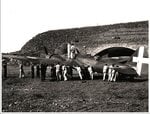Dewoitine D-520
As German forces invaded Vichy's so-called "free zone" in November 1942, they captured 246 D.520s; additionally, a batch of 62 was completed under German occupation. Some were used by the Luftwaffe for training purposes. The Germans also transferred 120 D.520s to Bulgaria and 60 to Italy. A number of them were intended for the Romanian Air Force, but the shipment was lost on the way. One source claims that they arrived and have been used against the Soviets, but says no details of service are known. Another source claims 150 aircraft were sent to Romania. Yet another source claims the so-called Romanian Dewoitines were in fact in transit to Bulgaria and only flew over Romania in order to get to their final destination. The latter seems the most reliable explanation viewed against the numbers of Dewoitines actually available.
Pictures below: Dewoitine D.520 before their transfer in Italy from Istres (France). On 1943 the Germans captured 246 D.520s and batch of 75 airplanes was transferred to Italy. The D.520 was a good plane, fast and well armed, forceful against the obsolete C.R,42s
Source: Captured aircrafts flown by the Regia - Official 1C Company forum
As German forces invaded Vichy's so-called "free zone" in November 1942, they captured 246 D.520s; additionally, a batch of 62 was completed under German occupation. Some were used by the Luftwaffe for training purposes. The Germans also transferred 120 D.520s to Bulgaria and 60 to Italy. A number of them were intended for the Romanian Air Force, but the shipment was lost on the way. One source claims that they arrived and have been used against the Soviets, but says no details of service are known. Another source claims 150 aircraft were sent to Romania. Yet another source claims the so-called Romanian Dewoitines were in fact in transit to Bulgaria and only flew over Romania in order to get to their final destination. The latter seems the most reliable explanation viewed against the numbers of Dewoitines actually available.
Pictures below: Dewoitine D.520 before their transfer in Italy from Istres (France). On 1943 the Germans captured 246 D.520s and batch of 75 airplanes was transferred to Italy. The D.520 was a good plane, fast and well armed, forceful against the obsolete C.R,42s
Source: Captured aircrafts flown by the Regia - Official 1C Company forum






